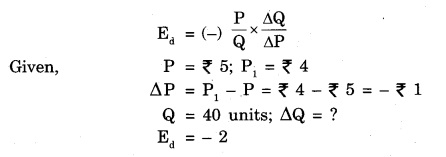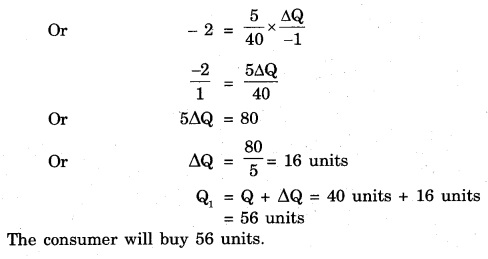Rajasthan Board RBSE Class 12 Economics Chapter 4 Price Elasticity of Demand
RBSE Class 12 Economics Chapter 4 Practice Questions
RBSE Class 12 Economics Chapter 4 Multiple Choice Questions
Question 1.
With increase in price, there is no change in demand of that commodity. This is called :
(a) perfectly inelastic
(b) unitary
(c) infinite
(d) perfectly elastic
Answer:
(a)
Question 2.
Due to increase in price in case of inelastic demand, what will be its effect on total expenditure of the consumer ?
(a) Unchanged
(b) Zero
(c) Increases
(d) Decreases
Answer:
(c)
Question 3.
Formula for elasticity of demand by geometric method :

Answer:
(a)
Question 4.
If price of “samosa” increases by 10% and its demand decreases to 10%, calculate the elasticity of demand.
(a) equal to unitary Ed
(b) Zero Ed
(c) greater than unitary Ed
(d) less than unitary Ed
Answer:
(a)
Question 5.
The elasticity of demand at point P in point method will be :
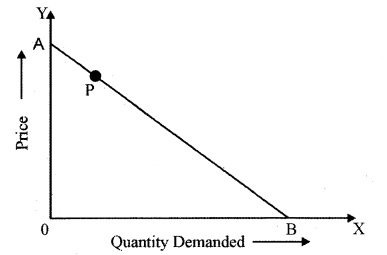
(a) Highly Ed
(b) Unitary Ed
(c) Inelastic demand
(d) None of the above
Answer:
(a)
RBSE Class 12 Economics Chapter 4 Very Short Answer Type Questions
Question 1.
Define price elasticity of demand.
Answer:
It is the measure of responsiveness of demand for a commodity to the change in any of its determinants, viz. price of the commodity, price of the substitutes and complements, consumers’ income and consumer expectation regarding prices.
Question 2.
If demand curve is parallel to X axis, find out elasticity of demand.
Answer:
If demand curve is paralled to X axis, then elasticity of demand is equal to infinity and this type of demand is called Perfectly Elastic Demand.
Question 3.
What will be the elasticity of demand at the middle of demand curve?
Answer:
At the middle of demand curve, elasticity will be equal to one, or it is called Unitary Elasticity of Demand.
Question 4.
Why is elasticity of demand for water inelastic?
Answer:
Demand for water is stable because if the price of water varies in the market, it does not have any effect on the demand because water is the most important element of life. People cannot survive without water.
Question 5.
Write the formula for finding out elasticity of demand by geometric method.
Answer:
Elasticity of demand (Ed) = Lower segment / Upper segment = \(\frac { MB }{ MA } \)
RBSE Class 12 Economics Chapter 4 Short Answer Type Questions
Question 1.
Explain any two factors affecting the price elasticity of demand.
Answer:
The two main factors affecting Ed are the following:
(i) Availability of Substitutions : The closer the substitute, the elasticity of demand for one commodity is higher. For example, coffee and tea can be considered alternatives to each other. If price of one of these goods increases, then the other commodity becomes relatively cheaper. Therefore, consumers buy more of the relatively cheaper goods and less-of the costlier one. The demand elasticity for both items will be high. Besides, the wider the range of the substitutes, the greater the elasticity.
(ii) Time Factor : Price-elasticity of demand also depends on the time that consumers take to adjust to a new price, when the long-term elasticity is high. For this, consumers are able to adjust their expenditure patterns for price changes over a period of time. For instance, if price of TV sets is decreased, demand will not immediately increase unless people possess excess purchasing power. But over time, people may be able to adjust their expenditure pattern so that they can buy a TV set at the (new) lower price.
Question 2.
Explain diagrammatically perfectly elastic and perfectly inelastic demand.
Answer:
(i)
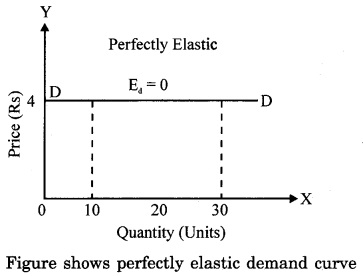
This above given figure is a diagrammatic representation of perfectly elastic demand. Curve DD is perfectly elastic demand curve that is parallel to axis OX. It represents that when the price is ₹ 4, the demand could be 10, 20 or 30 units. Any miniscule reduction in its price form, makes the demand infinite and a small rise in price results in fall in demand to zero. In this situation, elasticity of demand (Ed) = (∞).
(ii)
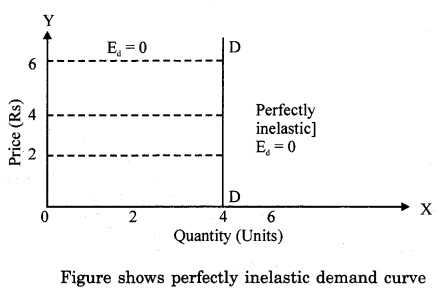
Above given diagrammatic representation is of perfectly inelastic demand. Here, the demand curve DD is parallel to OY-axis. If the price is ₹ 2, demand is for 4 units. When price increases from ₹ 4 to ₹ 6, the demand remains the same i.e., 4 units. Thus, change in price does not show any effect on demand. In this situation, elasticity of demand (Ed) is zero or Ed = 0.
Question 3.
How is elasticity of demand calculated by percentage method?
Answer:
The other name of this method is proportionate method. It is associated with Dr. Marshall. This method states that price elasticity of demand is the ratio of percentage change in the amount demanded to the percentage change in price of the commodity. It is expressed as given below formula:

Where; Ed = price elasticity of demand; Q = initial demand; Q1 = new demand; P = initial price; P1 = new price;
Note : The price elasticity of demand is always negative.
RBSE Class 12 Economics Chapter 4 Essay Type Questions
Question 1.
Explain diagrammatically the different categories of elasticity of demand.
Answer:
The categories of elasticity of demand are of the following five types:
(i) Perfectly Elastic Demand : A perfectly elastic demand refers to the condition when demand is infinite at the current price. It is the condition in which due to the little rise in price, the quantity demanded of the commodity falls to zero, and upon slight fall in price, the demanded quantity of commodity rises to infinity. Given below diagram represents perfectly elastic demand curve.
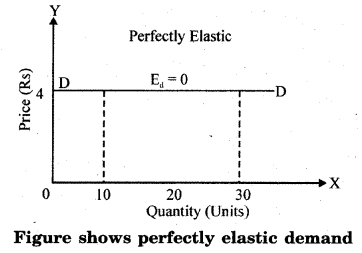
A curve DD which is parallel to OX-axis is a perfectly elastic demand curve. It represents that when the price of commodity slightly rise from ₹ 4, the demand of the commodity will fall to 0. At the current price of ₹ 4, the consumer can buy 10 or 20 or 30 units or any quantity that he wants. In this situation, elasticity of demand is uncertain, means infinite or Ed = (∞).
(ii) Less than Unitary Elastic Demand : Demand is less than unitary elastic if change in quantity demanded in reaction to change in price of the commodity is less. It occurs when total expenditure on the commodity reduces when price decreases, and total expenditure rises when price rises.
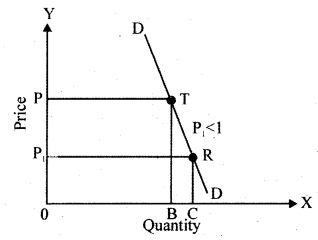
Figure shows less than unitary elastic demand (Ed < 1)
This figure represents, when price is OP, then quantity demanded is OB, sum total expenditure = OB*OP = OBTP (area). Similarly, when price is OPj and the quantity demanded is OC, then total expenditure = OCRP1 (area). It is clear that area of OBTP is greater than area of OCRP1 It indicates that total expenditure is decreased in the reaction to fall in price of the commodity. Therefore, elasticity of demand is lesser than a unit, (Ed < 1).
(iii)Unitary Elastic Demand : Unitary elastic demand is the demand in which the quantity demanded changes in response to change in price of the goods in such a way that the total expenditure on the goods remains stable.
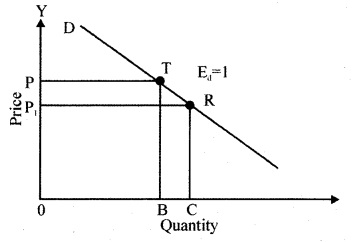
Figure shows the unitary elastic of demand
Figure represents that if price is OP, quantity demanded is OB, so total expenditure is
OB × OP = OBTP
Similarly, if price is OP1 total expenditure is
OC × OP1 = OCRP1
Here, OBTP = OCRP1
It means that total expenditure remains stable even that the price of commodities changes.
Therefore, elasticity of demand is equal to 1 or unit elasticity Ed = 1.
(iv) Greater than Unitary Elastic Demand : Demand is more than unitary elastic, if change in quantity demanded in reaction to change in price of the commodity is such that the total expenditure on the goods rises more in proportion to fall in price, when price decreases, and total expenditure falls more in proportion to rise in price, when price increases.
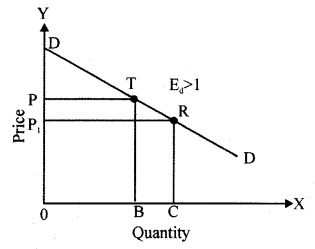
Figure shows greater than unitary elastic demand
In this figure, if price of commodity is OP, the quantity demanded is OB, and total expenditure is OB × OP = OBTP. Similarly, if price decreases to OP1, quantity demanded is OC, so that total expenditure is OC × OP1, = OCRP1 According to the graphical representation,
OCRP1 > OBTP
It means that total expenditure rises more in proportion in reaction to fall in price of the commodity.
Therefore, the elasticity of demand is more than or greater than unity, Ed > 1.
(v) Perfectly Inelastic Demand : A perfectly inelastic demand is the demand in which there is no effect on quantity demanded when the price changes (falls or rises). It is the condition where even substantial changes in price leave the demand unaffected.
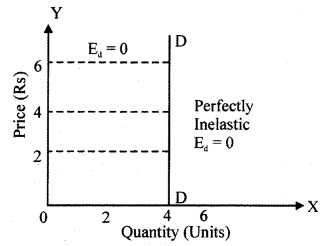
Figure shows the perfectly inelastic demand
The diagram represents that the demand is perfectly inelastic. A curve DD is parallel to axis-0Y. If price is ₹ 2, then demand is 4 units. When price increases to ₹ 4, the demand remains stable, i.e., ₹ 4 units. Therefore, there is no change in demanded quantity if the price increases, hence, elasticiy of demand is equal to 0.
Question 2.
Explain different methods of measurement of elasticity of demand.
Answer:
There are three methods of measurement of elasticity of demand. These are given below:
(i) Total Expenditure or Total Outlay Method : In this method, we measure the effect of change in price on total expenditure. We can presume three possible conditions:
(a) When the price change (price increase or decrease) does not show any impact on total expenditure, it is called the Position of Unitary Elastic Demand.
(b) When the price change shows the impact on total expenditure. If because of rise in price, total expenditure decreases and if fall in price shows total expenditure increase, it is known as Greater than Unitary Elastic Demand.
(c) When the price change shows the impact on total expenditure. If because of rise in price, total expenditure increases and if fall in price shows total expenditure decrease, it is known as Less than Unitary Elastic Demand.
Given below diagram shows the total expenditure method:
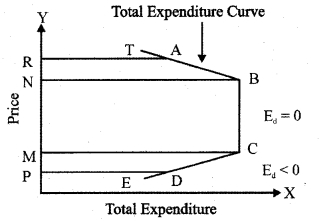
This graphical representation shows that axis-OY shows price and the axis-OX shows total expenditure curve. TE is the curve of total expenditure. Curve BC represents unitary elastic demand. It represents that if price is OM, then total expenditure is MC, when price increases to ON, then total expenditure remains constant.
Here, NB = MC
TB curve shows greater than unitary elastic demand. It represents that if there is rise in price from ON to OR, total expenditure decreases from NB to RA. Curve EC shows less than unitary elasticity of demand. It represents that when the price reduces from OM to OP, then the total expenditure also decreases from MC to PD.
(ii) Proportionate or Percentage Method : Proportionate or percentage method is proposed by Marshall. Elasticity of demand is measured by the ratio of the proportionate change in quantity demanded to the proportionate change in price.

(iii) Geometric Method : It is the method through which elasticity of demand is measured at differents point of the curve. It is also known as ‘Point Method.’
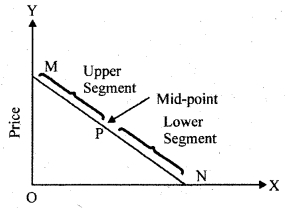
The figure shows that MN is a straight line demand curve. A specific point on the demand curve is ‘P. ‘This point divides the demand curve into two parts, viz. lower part PN and upper part PM. Point P is the ratio between lower segment and upper segment.

Question 3.
Explain in detail the factors affecting elasticity of demand.
Answer:
The factors affecting elasticity of demand are the following :
(i) Availability of Substitutes : The most significant determinant of price elasticity of demand for a commodity is the availability of its alternatives. The elasticity of demand for a commodity increases as much as it is close to the alternative. For example, coffee and tea can be considered as a close alternative to each, other, if the price of one of these goods rises, then the second commodity becomes relatively cheaper. Therefore, consumers buy cheaper and less expensive goods.
(ii) Nature of Commodity : The price elasticity of demand depends on the nature of a commodity. Commodities can be broadly divided on the basis of their nature as luxury, comforts and requirements. Luxury goods’ demand is more elastic than the demand for other types of goods because consumption of luxury goods can be postponed when their price rises. On the other hand, consumption of essential goods cannot be postponed and hence their demand is inelastic. Demand for durable goods is more elastic than that for non-durable goods, because when the price of the former increases, people either get the old one repaired instead of replacing it or buy a ‘second hand’ product.
(iii) Proportion of Income spent: Another factor affecting the elasticity of demand is the proportion of income which consumers spend on a particular commodity. If proportion of income spent on a commodity is very small, then its demand will be inelastic, and vice-versa. The classic examples of such commodities are salt, matches, books, toothpastes, etc., which claim a very small proportion of consumers’ income. Demand for these goods is generally inelastic because increase in the price of such goods does not substantially affect the consumer’s budget, and hence its demand.
(iv) Time Factor : The price elasticity of demand also depends on how much time consumers take to adjust to a new price. The more time it takes, the more elastic the demand will be. is. For, consumers are able to adjust their expenditure pattern to price changes over a period of time. For example, if price of TV sets is decreased, demand will not immediately increase unless people possess excess purchasing power. But over time, people may be able to adjust their expenditure pattern so that they can buy a TV set at the new lower price.
(v) Range of Alternative Uses of a Commodity : The wider the range of alternative uses of a product, the higher the elasticity of its demand. Decreases in the price of a multi-use commodity encourages the extension of their use. Therefore, the demand : for such a commodity generally increases more than the proportionate decrease in its price. For instance, milk can be taken as it is, it can be converted into curd, cheese, ghee and butter milk. The demand for milk, will therefore be highly elastic. Similarly, electricity can be used for lighting, cooking, heating and for industrial purposes, therefore, demand for electricity is elastic, especially, for decrease in price.
(vi) The Proportion of Market Supplied : The elasticity of market demand depends also on the proportion of the market supplied at the ruling price. If less than half of the market is supplied, elasticity of demand will be higher and if more than half of the market is supplied, elasticity will be lower. That is, towards the upper end, demand curve is more elastic than towards the lower end.
(vii) Direction of Change in Price : The direction of change in price also determines the elasticity. Between any two finite points on the demand curve, elasticity is higher for the fall in price and vice-versa.
RBSE Class 12 Economics Chapter 4 Other Important Questions – Answers
RBSE Class 12 Economics Chapter 4 Multiple-Choice Questions
Question 1.
If a good is a luxury, its income elasticity of demand is :
(a) positive and less than 1
(b) negative but greater than -1
(c) positive and greater than 1
(d) zero
Answer:
(c)
Question 2.
The price of burger increases by 22% and the quantity of burgers demanded falls by 25%. This indicates that demand for burger is :
(a) elastic
(b) inelastic
(c) unitary elastic
(d) perfectly elastic
Answer:
(a)
Question 3.
If the quantity demanded of edible oil increases by 5% when the price of ghee increases by 20%, the cross-price elasticity of demand between edible oil and ghee is
(a) -0.25
(b) 0.25
(c) – 4
(d) 4
Answer:
(b)
Question 4.
Given the four possibilities, which one results in an increase in total consumer expenditure?
(a) Demand is unitary elastic and price falls
(b) Demand is elastic and price rises
(c) Demand is inelastic and price falls
(d) Demand is inelastic and price rises
Answer:
(d)
Question 5.
The price elasticity of demand is defined as the responsiveness of :
(a) price to change in quantity demanded
(b) quantity demanded to a change in price
(c) price to a change in income
(d) quantity demanded to a change in income
Answer:
(b)
Question 6.
Suppose the price of drama seen at a theatre rises from ₹ 120 per person to ₹ 200 per person. The theatre manager observes that the rise in price causes attendance at a given movie to fall from 300 persons to 200 persons. What is the price elasticity of demand for movies?
(a) 0.5
(b) 0.8
(c) 1.0
(d) 1.2
Answer:
(b)
Question 7.
Suppose a shop has a sale on its silverware. If the price of a silver earrings is reduced from ₹ 300 to ₹ 200 and the quantity demanded increases from 3,000 earrings to 5,000 earrings, what is the price elasticity of demand for silverware?
(a) 0.8
(b) 1.0
(c) 1.25
(d) 1.50
Answer:
(c)
Question 8.
A discount store has a special offer on CDs. It reduces their price from ₹ 150 to ₹ 100. Suppose the store manager observes that the quantity demanded increases from 700 CDs to 1,300 CDs. What is the price elasticity of demand for CDs?
(a) 0.8
(b) 1.0
(c) 1.25
(d) 1.50
Answer:
(d)
Question 9.
If the local sweet house raises the price of sonpapri from ₹ 60 to ₹ 100 and quantity demanded falls from 700 sweets a night to 100 sweets a night, the price elasticity of demand for sweet is :
(a) 0.67
(b) 1.5
(c) 2.0
(d) 3.0
Answer:
(d)
Question 10.
If electricity demand is inelastic, and electric rates increases, which of the following is likely to occur?
(a) Quantity demanded will fall by a relatively large amount
(b) Quantity demanded will fall by a relatively small amount
(c) Quantity demanded will rise in the short-run, but fall in the long run
(d) Quantity demanded will fall in the short-run, but rise in the long run
Answer:
(b)
Question 11.
Suppose the demand for a deluxe thali at a medium-priced restaurant is elastic. If the management of the restaurant is considering raising prices, it can expect a relatively :
(a) larger fall in quantity demanded
(b) larger fall in demand
(c) smaller fall in quantity demanded
(d) smaller fall in demand
Answer:
(a)
Question 12.
Point elasticity is useful for which of the following situations?
(a) The bookstore is considering doubling the price of notebooks
(b) A restaurant is considering lowering the price of its most expensive dishes by 50%
(c) An auto producer is interested in determining the response of consumers to the price of cars being lowered by ₹ 100
(d) None of the above
Answer:
(c)
Question 13.
A decrease in price will result in an increases in total revenue if :
(a) the percentage change in quantity demanded is less than the percentage change in price
(b) the percentage change in quantity demanded is greater than the percentage change in price
(c) demand is inelastic
(d) the consumer is operating along a linear demand curve at a point at which the price is very low and the quantity demanded is very high
Answer:
(b)
Question 14.
An increase in price will result in an increase in total revenue if :
(a) the percentage change in quantity demanded is less than the percentage change in price
(b) the percentage change in quantity demanded is greater than the percentage change in price
(c) demand is elastic
(d) the consumer is operating along a linear demand curve at a point at which the price is very high and the quantity demanded is very low
Answer:
(a)
Question 15.
Demand for a good will tend to be more elastic if it exhibits this characteristic
(a) It represents a small part of the consumer’s income
(b) The good hgs many substitutes available
(c) It is a necessity (as opposed to luxury)
(d) There is little time for the consumer to adjust to the price changes
Answer:
(b)
Question 16.
Demand for a good will tend to be more inelastic if it exhibits the following characteristics —
(a) The good has many substitutes
(b) The good is a luxury (as opposed to a necessity)
(c) The good is a small part of the consumer’s income
(d) There is a great deal of time for the consumer to adjust to the change in prices
Answer:
(c)
Question 17.
The concept of elasticity of demand was evolved by :
(a) T.R. Malthus
(b) J. Bentham
(c) J.S. Mill
(d) Ricardo
Answer:
(c)
Question 18.
Price elasticity of demand can be measured by using :

Answer:
(c)
Question 19.
If demand is inelastic, a rise in price :
(a) makes no change in consumer expenditure
(b) increases consumer expenditure
(c) decreases consumer expenditure
(d) cannot determine consumer expenditure
Answer:
(b)
Question 20.
When cross elasticity of demand for two goods is cheaper, then they can be regarded as :
(a) complements
(b) substitutes
(c) perfect substitutes
(d) None of these
Answer:
(d)
Question 21.
Demand for a commodity is elastic when it has :
(a) uses very essential for the consumer
(b) many uses
(c) only one use
(d) uses which cannot be postponed
Answer:
(b)
Question 22.
Match the effects of rise in price on consumer expenditure and elasticities of demand :

Answer:
(c)
Question 23.
Suppose price of a commodity falls and its demand increases so much that elasticity is estimated to be 1.25. Suppose price increases back to its old level. The price elasticity will be –
(a) the same
(b) less than 1.25
(c) higher than 1.25
(d) less than 1.0
Answer:
(b)
Question 24.
At a given price, two parallel demand curves have :
(a) the same point elasticity
(b) a different point elasticity
(c) Both (a) and (b)
(d) None of these
Answer:
(b)
Question 25.
Two intersecting demand curves have at the point of their intersection –
(a) the same elasticity
(b) a different elasticity
(c) Both (a) and (b)
(d) None of these
Answer:
(b)
Question 26.
A less than zero income elasticity indicates that with an increase in income, consumption of a product –
(a) turns negative
(b) increases
(c) decreases
(d) remains constant
Answer:
(c).
RBSE Class 12 Economics Chapter 4 Very Short Answer Type Questions
Question 1.
What is elasticity of demand?
Answer:
The elasticity of demand is the measurement of responsiveness of demand for a commodity to the change in any of its determinants, viz., price of the commodity, price of the substitutes and complements, consumers’ income and consumers’ expectations regarding prices.
Question 2.
What do you understand by price elasticity of demand?
Answer:
The price elasticity of demand is defined as the degree of responsiveness or sensitiveness of demand for a commodity to the change in its price.
Question 3.
What is perfectly elastic demand?
Answer:
This is a demand in which there are very large changes in demand due to slight changes in price.
Question 4.
What is meant by perfectly inelastic demand?
Answer:
This is a demand in which there is no change in demand due to price change.
Question 5.
When is demand elastic?
Answer:
When due to slight changes in price, the demand of the commodity changes in the market.
Question 6.
When is demand inelastic?
Answet:
When if there is no impact of change in price on the demand of commodity, the demand is inelastic.
Question 7.
When is elasticity of demand called unitary?
Answer:
Elasticity of demand is said to have unitary elasticity, when a certain percentage change in price produces an equal percentage change in demand.
Question 8.
What will be the elasticity of demand for goods, to which consumers are addicted?
Answer:
Goods to which a person becomes accustomed or addicted will have inelastic demand, like cigareette, coffee, tobacco, etc. It is so, because a person doesn’t want to live without these kind of goods. Mostly, these kind of goods are injurious for health.
Question 9.
What will be’ the elasticity of demand when:
| Price (in ₹) | Quantity Demanded (Units) | Total Expenditure (in X) |
| 6 | 5 | 30 |
| 5 | 6 | 30 |
Answer:
Elasticity of demand is equal to unity. Because, in response to a change in price, total expenditure has not changed even when quantity demanded has increased.
Question 10.
What is the formula of geometric method of elasticity of demand?
Answer:

Question 11.
What is the formula of percentage method of elasticity of demand?
Answer:

Question 12.
The demand for a commodity does not change with the increase in its price from ₹ 5 to ₹ 10. What is its elasticity of demand?
Answer:
Inelastic demand.
Question 13.
Why is the perfectly elastic demand curve parallel to OX-axis?
Answer:
The fully elastic demand curve is parallel to the OX-axis because it indicates that when the value of the item changes slightly, the demand falls rapidly.
Question 14.
Give the formula to measure elasticity of demand on a straight line demand curve.
Answer:

Question 15.
How do we measure arc elasticity?
Answer:
The elasticity co-efficient between any two finite points on a demand curve, i.e. arc elasticity, can be measured by using the given below formula:

Question 16.
What do you mean by cross elasticity?
Answer:
According to Ferguson, “The cross elasticity of demand is the proportional change in the quantity demanded of goods X divided by the proportional change in the price of the related goods Y.”
Question 17.
What is meant by income elasticity?
Answer:
According to Watson, “Income elasticity of demand means the ratio of the percentage change in the quantity demanded to the percentage change in income.”
Question 18.
What is zero income elasticity of demand?
Answer:
This refers to the situation where a given increase in consumer’s money-income does not result in any increase of the quantity demanded of the commodity. Zero income elasticity of demand is expressed as Y = 0.
Question 19.
What is negative income elasticity of demand?
Answer:
This refers to that situation where a given increase in the consumers money-income is followed by an actual fall in the quantity demanded of the commodity. This happens in the case of economically inferior goods.
Question 20.
What is positive income elasticity?
Answer:
An increase in income may lead to an increase in the quantities demanded. For most goods, the income elasticity of demand is expressed as Y < 0.
RBSE Class 12 Economics Chapter 4 Short Answer Type Questions (SA-I)
Question 1.
Define price elasticity of demand.
Answer:
Price elasticity of demand expresses the response of quantity demanded of a good to a chhnge in its price, given the consumer’s income, his tastes and, prices of all other goods remain the same. In other words, it is measured as percentage change in quantity demanded divided by the percentage change in price, other things remaining equal. That is,

According to Alfred Marshall in his famous book, ‘Principles of Economics’, while introducing the concept of the elasticity of demand, “The elasticity of demand in a market is great or small according to whether the amount demanded increases much or little for a given fall in price, and diminishes much or little for a given rise in price.”
Question 2.
How is price elasticity of demand measured?
Answer:
It is measured as percentage change in quantity demanded divided by the percentage change in price, other things remaining equal. That is,

In other words, elasticity is the percentage change in quantity divided by the percentage change in price. If the percentages are known quantities, then the numerical size of Ep can be easily calculated. Let us suppose that the percentages are 5 for quantity and 1 for price, and that the price falls, since it falls, the price changes by minus 1%. Then,
![]()
Question 3.
Write down three factors on which the price elasticity of demand depends.
Answer:
The price elasticity of demand varies from commodity to commodity, depending on the nature of the commodity. While the demand for some commodities is highly elastic, for some, it is highly inelastic. Some important factors and determinants of price elasticity of demand are given below:
(i) Availability of Substitutes : One of the most important determinants of price elasticity of demand for a commodity is the availability of its substitute. The closer the substitute, the greater the elasticity of demand for a commodity.
(ii) Nature of Commodity : Price elasticity of demand depends also on the nature of a commodity. Commodities can be grouped broadly as luxuries, comforts and necessities, on the basis of their nature.
(iii) Proportion of Income Spent : Another factor that influences the elasticity of demand is the proportion of income which the consumers spend on a particular commodity. If the proportion of income spent on a commodity is very small, its demand will be inelastic, and vice-versa.
Question 4.
What are the types of elasticity of demand?
Answer:
On the basis of elasticity as a ratio, i.e. a ratio of change in quantity demanded to a change in the price of a commodity, we can distinguish between five types of elasticity as follows:
(i) Perfectly Elastic Demand : Demand for a commodity is said to be perfectly elastic when the demand for it may increase or decrease to any extent irrespective of any change or infinite change in its price.
(ii) More than Unit Elastic Demand : Demand for a commodity will be said to be elastic if a change in price results in a significant change in demand for this commodity.
Question 5.
Write down the two main points of importance of elasticity of demand.
Answer:
The two main points which show the importance of elasticity of demand are:
(i) For Finance Minister : The finance minister imposes taxes on those whose demand is price-insecure so that tax revenues increase. Similarly, on indirect taxes, the finance minister imposes a tax on the items which have a continuous demand among the rich section and thus the burden of taxes is levied on the rich class.
(ii) For Taking Over Public Utility Services : State takeing over of public utility services can also be explained with the help of elasticity of demand. Demand for public utilities such as electricity and water supply, posts and telegraphs, public transportation, etc., is generally inelastic in nature. If operation of such public utilities is entrusted to private individuals, they are likely to exploit the consumer. Therefore, in the interest of social welfare, the government owns and runs such services.
Question 6.
What do you understand by income elasticity of demand?
Answer:
The income elasticity may be defined as the ratio of the percentage change in purchases of a good to the change in income which induces the former. It is the degree of response of quantity demanded to a change in income, and it is measured by dividing the proportionate change in quantity demanded by the proportionate change in income. According to Watson, “Income elasticity of demand means the ratio of the percentage change in the quantity demanded to the percentage change in income.”
Question 7.
What is the problem in using arc elasticity? How can this problem be resolved?
Answer:
The arc elasticity coefficient should be used with caution because the measure of arc elasticity between any two points on a demand curve produces two different elasticity coefficients for the same fall and rise in price. The arc elasticity coefficient varies between the same two finite points on a demand curve when the direction of change in price is reversed. Therefore, it is the cause of misinterpretation.
Question 8.
Compare the elasticity of two parallel demand curves at a given price.
Answer:
Let us suppose that two demand curves have the same slope and different elasticities at a given price. Now see the demand curve JK and LM in given below figure. The demand curve JK and LM both are parallel and thus both have the same slope. Point R on the demand curve JK and point Q on the demand curve LM represents the amount or quantities demanded at a given price, OP.
The elasticity at point R on demand curve JK is RK/RJ and elasticity at point Q on demand curve LM is QM/QL. It can be proved through the graph that :
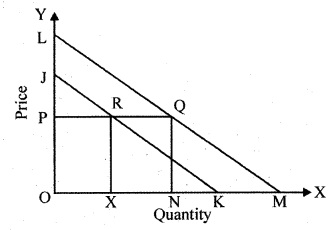
Different Elasiticities of Parallel Demand Curves
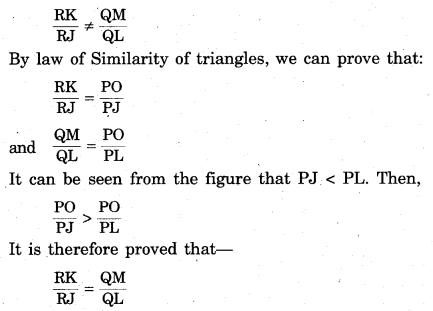
It can be concluded from the above findings that demand of the same slope curves may vary, and the demand for different slope curves can be similar at a fixed price.
Question 9.
Explain with the help of a diagram, the geometric method of measuring price elasticity of demand.
Answer:
Geometric method measures elasticity of demand at different points on the demand curve. It is also known as ‘Point Method’ of measuring elasticity of demand.
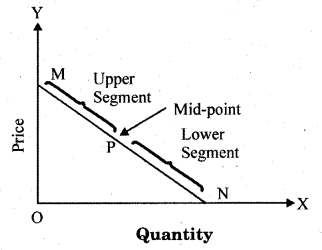
The figure shows that MN is a straight line demand curve. A specific point on the demand curve is ‘P. ‘This point divides the demand curve into two parts, viz., lower part PN and upper part PM. Elasticity of demand at Point P is the ratio between lower segment and upper segment.

Question 10.
If a product’s price increases, a family spending on the product has to increase, is this observation correct ?
Answer:
When a product’s price increases, a family spending on the product does not increase because either the family will use a substitute of that product or it will discontinue the use of the product, if price increases.
Question 11.
Suppose demand schedule is given as follows:
| Price (in ₹) | 100 | 80 | 60 | 40 | 20 | 0 |
| Quantity | 100 | 200 | 300 | 400 | 500 | 600 |
(i) Find the elasticity for the fall in price from ₹ 80 to ₹ 60.
(ii) Calculate the elasticity for the increase in price from ₹ 60 to ₹ 80.
Answer:
(i) When the price fall is from ₹ 80 to ₹ 60, the demanded quantity of the product increases from 200 to 300. Hence, here : P = 60, ∆P = 20, Q = 300, ∆Q = 100

(ii) When the price increases from ₹ 60 to ₹ 80, the demanded quantity of the product decreases from 300 to 200. Hence, here P = 80, ∆P = 20, Q = 200, ∆Q = 100

RBSE Class 12 Economics Chapter 4 Long Answer Type Questions
Question 1.
Explain any five factors determining price elasticity of demand.
Answer:
Given below are the factors which determine the price elasticity of demand:
(i) Nature of Commodity : Ordinarily, necessities like salt, kerosene oil, matchboxes, textbooks, seasonal vegetables, etc. have less than unitary elastic (inelastic) demand. Luxuries, like air-conditioner, costly furniture, fashionable garments, etc. have greater than elastic demand. The reason being that any change in their prices has a great effect on their demand. Comforts like milk, transistor, cooler, fans, etc. have neither very elastic nor very inelastic demand. Jointly demanded goods, like car and petrol, pen and ink, camera and film, etc. have ordinarily inelastic demand.
(ii) Availability of Substitutes : Demand for those commodities which have a substitute (for example, tea has its substitute in coffee, orange juice has its substitute in lime juice) are relatively more elastic.
(iii) Different Uses of Commodity : Commodities that can be put to a variety of uses have elastic demand. For instance, electricity has multiple uses. It is used for lighting, room-heating, air-conditioning, cooking, etc. If the tariffs of electricity increase, its use will be restricted to important purposes like lighting. It will be withdrawn from less important uses. On the other hand, if a commodity such as paper has only a few uses, its demand is likely to be inelastic.
(iv) Income of Consumer : People whose incomes are very high or very low, their demand will ordinarily be inelastic. Because rise or fall in price will have little effect on their demand. Conversely, middle income groups will have elastic demand.
(v) Habit of Consumer : Goods to which a person becomes accustomed or habitual will have inelastic demand like cigareette, coffee, tobacco, etc. It is so, because a person cannot do without them.
Question 2.
Define price elasticity of demand for a commodity. What would be the shape of a demand curve of a commodity when its price elasticity of demand is
(i) Zero
(ii) Infinite?
Answer:
(i) Zero Condition of Demand Elasticity : A perfectly inelastic demand is the demand in which there is no effect on quantity demanded when the price changes. It is the condition where even significant changes in price leave the demand unaffected.
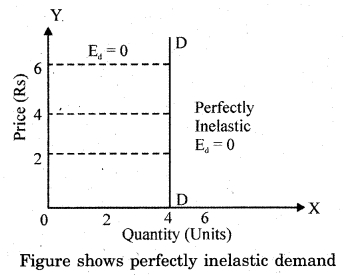
The diagram represents that the demand is perfectly inelastic. A curve DD is parallel to axis-OY. If price is ₹ 2, then demand is 4 units. When price increases to ₹ 4, the demand remains stable, i.e., ₹ 4 units. Therefore, no change occurs in demand, if the price increases. Elasticity of demand is equal to 0.
(ii) Infinite Condition of Demand Elasticity : A perfectly elastic demand refers to the condition when demand is infinite at the current price. It is the condition in which due to a little rise in price the quantity demanded of the commodity falls to zero. Given below diagram represents perfectly elastic demand curve.
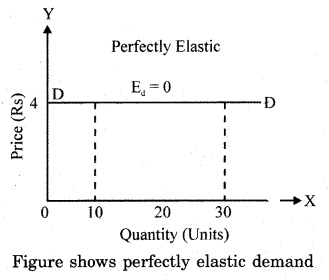
A curve DD which is parallel to OX-axis is a perfectly elastic demand curve. It represents that when the price of commodity slightly rises from ₹ 4, the demand of the commodity will fall to 0. At the current price of ₹ 4, the consumer can buy 10 or 20 or 30 units or any quantity that he wants. In this situation, elasticity of demand is uncertain, means infinite or Ed = (∞).
Question 3.
What do you understand by price elasticity of demand? How is it measured?
Answer:
Price elasticity of demand expresses the response of quantity demanded of a good to a change in its price, given the consumer’s income, his tastes and prices of all other goods remain the same. In other words, it is measured as percentage change in quantity demanded divided by the percentage change in price, other things remaining equal. That is

According to Alfred Marshall in his famous book, ‘Principles of Economics’, while introducing the concept of the elasticity of demand, says; “The elasticity of demand in a market is great or small according to whehter the amount demanded increases much or little for a given fall in price, and diminishes much or little for a given rise in price.”
(i) Total Expenditure or Total Outlay Method : In this method, we measure the effect of change in price on total expenditure. We can presume three possible conditions:
- When the price, change (price increase or decrease) does not show the impact on total expenditure, it is called the Position of Unitary Elastic Demand.
- When the price change shows the impact on total expenditure. If because of rise in price, total expenditure decreases and if fall in price shows total expenditure increase, it is known as Greater than Unitary Elastic Demand.
- When the price change shows the impact on total expenditure. If because of rise in price, total expenditure increases and a fall in price shows total expenditure decrease, it is known as less than Unitary Elastic Demand.
Given below diagram show the total expenditure method:
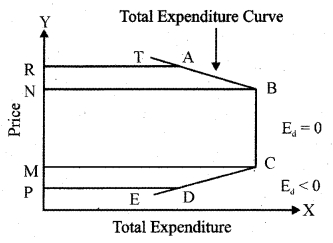
This graphical representation shows that axis-OY shows price and the axis-OX shows total expenditure curve. TE is the curve of total expenditure. Curve BC represents unitary elastic demand. It represents that if price is OM, then total expenditure is MC, when price increases to ON, then total expenditure remains constant.
Here, NB = MC
TB curve shows greater than unitary elastic demand. It represents that if there is rise in prices from ON to OR, total expenditure decreases from NB to RA. Curve EC shows less than unitary elasticity of demand. It represents that when the price reduces from OM to OP then the total expenditure also decreases from MC to PO.
(ii) Proportionate or Percentage Method : Proportionate or percentage method is proposed by Marsliall. Elasticity of demand is measured by the ratio of the proportionate change in quantity demanded to the proportionate change in price.

(iii) Geometric Method : It is the method through which elasticity of demand is measured at different points of the demand curve. It is also known as ‘Point Method’.
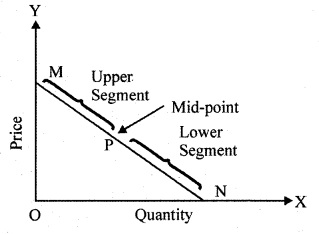
The figure shows that MN is a straight line demand curve. A specific point on the demand curve is ‘P’. This point divides the demand curve into two parts, viz., lower part PN and upper part PM. Elasticity of demand at point P is the ratio between lower segment and upper segment.

Question 4.
What is the importance of the study of elasticity of demand?
Answer:
The importance of the study of elasticity of demand is given below:
(i) For the Businessman : A knowledge of the nature of the elasticity of demand for his products will help a businessman to decide whether he can cut prices in a particular case or not. In general, for items where the demand is elastic, it will pay him to charge relatively low prices, while those whose demand is inelastic are better with higher prices.
(ii) For Monopolist : The price elasticity concept is very important, particularly to a monopolist who decides his own prices for goods. If the demand for their goods is inelastic, it would be beneficial to charge it at a higher price and sell a slightly smaller volume. If demand is elastic, it will be beneficial to charge a lower price and increase the sales volume.
(iii) For Finance Minister : Whenever the finance minister considers raising the rates of tax on existing tax items in view of the introduction of fresh levy on some items or for getting more revenue for the state, he conducts a thorough study of the elasticity of demand for commodity. The finance minister often taxes those items less whose demand is price-elastic. This leads to an increase in the taxation revenue from indirect taxes. In contrast, the finance minister taxes those items highly which are constantly demanded by the rich class and the burden of taxation is laid more on the rich class.
(iv) For Determination of Prices of Joint Products : The concept of elasticity of demand is used in the value of combined products, such as cotton and cotton seeds, wool and mutton, wheat and straw etc. It is not possible to find individual marginal costs of combined products here. During price fixing, producers are mostly directed by elasticity of demand. But its total receipts must cover the total cost. Transport authorities have decided to fix their rates according to the principle that ‘what will be the traffic’.
(v) For Explaining the Paradox of Poverty in the Midst of Plenty: The concept of elasticity of demand suitably explains the parodox of poverty in the midst of plenty. For example, if there is a bumper crop of wheat, then it can give farmers a signal of calamity rather than prosperity, if the demand for wheat is incompatible. Due to the increase in supply, the decline in the price of wheat will reduce the income of the farmers.
(vi) For Determining Reward of Factors of Production : The elasticity of demand is equally important in determining the awards of various factors of production in the country. For example, if demand for workers is elastic, trade unions’ efforts to meet the wages of workers will be met with failure. On the contrary, if demand for labour in a particular area is real, then trade unions can get more wages from the employer. This is also true about other factors of production. The factors of production that have more elastic demand, they accept small prizes; and the factors having an inelastic demand can be provided a big reward.
(vii) For Taking Over Public Utility Services : The state’s decision can also be explained with the help of the elasticity of demand for acquisition of public utility services. Demand for public utilities such as electricity and water supply, posts and telegraphs, public transport, etc. is generally inelastic in nature. If such public utility is assigned to private iiidividuals, then they are likely to exploit the consumer. Therefore, in the interest of social welfare, the government is the owner of such services and runs these services. For example, in Bombay City, the bus service was operating privately in the suburban areas. It was later acquired by the Greater Bombay Municipal Corporation.
(viii) For Pricing Policy for Public Utilities : Price elasticity is also influential in determining the price policy of public utility undertakings, like electric supply undertakings, railways, etc. Such undertakings determine their rates for different uses on the basis of the elasticity of demand and try to cover the losses from one group of users out of the gains reaped from the other group.
(ix) Terms of Trade Between Two Countries : In international trade, the price elasticity of demand is helpful in ascertaining the ‘terms of trade’. If exports have inelastic demand, a higher price can be charged from abroad. Similarly, if imported goods have elastic demand in the domestic market, a lower price is to be fixed. Both these enable a country to have favourable ‘terms of trade’ in respect of international trade.
(x) Determination of Rates of Foreign Exchange : In order to determine the foreign exchange rates for domestic currency, the government must keep in mind the elasticity of demand for its exports and imports. This will help the government to know the potential effects of devaluation or re-evaluation of its currency with respect to foreign currencies. If the government devalues the currency without carefully studying the elasticity of demand and demand for the country’s exports, then it cannot be successful in achieving its goal.
(xi) For Price Control Policy : In undeveloped countries like India, the price control policy can be adopted only after assessing the value of strategic goods demand. In terms of low-level items with elasticity or redundant demand, price control is usually used.
(xii) For Tariff Policy : Imposition of tariff raises the prices of domestic goods. The extent to which the internal price rises, depends on the elasticity of demand of the protected goods. If the demand for the protected goods is elastic, their sales will be reduced with the rise in prices. On the contrary, if the demand is less elastic, people will have to bear the burden of higher prices as a result of the tariff policy.
(xiii) Incidence of Taxation : Incidence of tax lies on the person who ultimately pays the tax. The incidence is on the buyer. If demand is perfectly inelastic, he will go on buying, as much as before, despite the price rise. The government has to keep in mind the ultimate burden of the tax, which depends on the elasticity of demand of the commodity taxed. If necessities, which have less elastic demand, are taxed, the burden will fall more on the poor section of society.
Question 5.
Explain with a diagram point elasticity method or geometric method of determining the elasticity of demand. Explain with a diagram arc elasticity of demand.
Answer:
(i) Geometric Method : Geometric method measures elasticity of demand at different points on the demand curve. It is also known as ‘Point Method’ of measuring elasticity of demand.
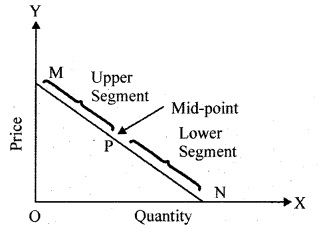
The figure shows that MN is a straight line demand curve. A specific point on the demand curve is ‘P’. This point divides the demand curve into two parts, viz. lower part PN and upper part PM. Elasticity of demand at point P is the ratio between lower segment and upper segment.

(ii) Arc Elasticity of Demand : When price-elasticity of demand is measured between any two finite points on a demand curve, it is called Arc Elasticity.
The elasticity co-efficient between any two finite points on a demand curve, i.e. arc elasticity, can be measured by using the formula. For example, the measure of elasticity between points J and K on the demand curve PM in the given figure is the measure of arc elasticity. The movement from point J to K on the straight line demand curve PM shows a fall in price of commodity X from ₹ 25 to if ₹ 15 and the consequent increase in demand from 30 units to 50 units. Here, ∆P = 25 – 15 = 10 and ∆Q = 50 – 30 = 20. The arc elasticity between points J and K (moving from J to K ) can be calculated as given below:

Explanation : Elasticity coefficient is interpreted as percentage change in demand due to one per cent change in price. For example, in equation. (1), elasticity coefficient is 1.66. The elasticity coefficient will be interpreted as : 1 per cent decrease in price of commodity X results in a 1.66 per cent increase in demand for it
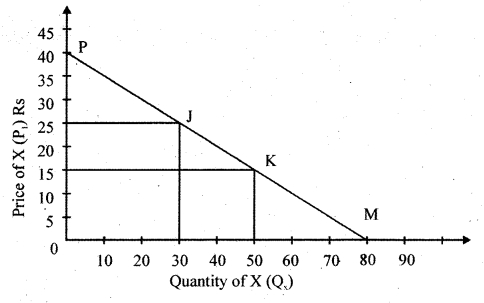
RBSE Class 12 Economics Chapter 4 Numerical Questions
Question 1.
A consumer purchased 10 units of a commodity when its price was ₹ 5 per unit. He purchased 12 units of the commodity when its price falls to ₹ 4 per unit. What is the price elasticity of demand for the commodity at that price?
Solution:
![]()
Given, P = ₹ 5; Q = 10 units, P1 = ₹ 4, Q1 = 12 units
So, ∆P = P1 – P = ₹ 4 – ₹ 5 = – ₹ 1
∆Q = Q1 – Q = 12 – 10 = 2 units
Putting these values in given above formula,
Ed = \(\frac { -5 }{ 10 } \) × \(\frac { 2 }{ -1 } \) = 1 (unitary)
Question 2.
A consumer buys 50 units of a good at ₹ 4 per unit. When its price falls by 25 per cent, its demand rises to 100 units. Find out the price elasticity of demand.
Solution:

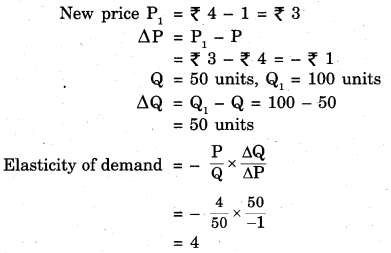
Elasticity of demand = 4 (Greater than unity)
Question 3.
As a result of 10% fall in price of a good, its demand rises from 100 units to 120 units. Find out the price elasticity of demand.
Solution:
Given,
Percentage change in price = 10%
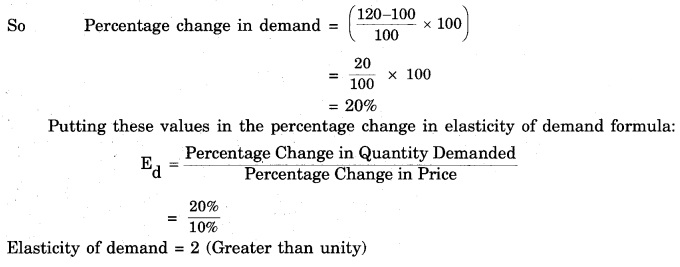
Question 4.
Calculate the price elasticity of demand by proportionate/percentage method if Q1 = 4,000, Q2 = 5,000, P1 = ₹ 20, P2 = ₹ 19.
Solution:
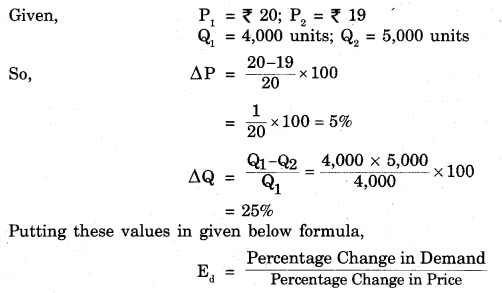

Question 5.
Below is given a demand equation Q = – 6P + 400
Calculate price elasticity of demand if price is (i) ₹ 4, (ii) ₹ 10 and, (iii) ₹ 15. Is the demand at these prices elastic or inelastic ?
Solution:
A most appropriate way of calculating price elasticity of demand in such cases is point elasticity method. This consists of the following steps:
(i) Calculate P1 (Price at which quantity demanded is zero). When Q is Zero.
(ii) Calculate the difference between ruling price (P2) and the price at which quantity demanded is zero (P1), i.e., calculate P2 – P1.
(iii) Divide the ruling price (P2) by the difference as obtained in (2) above.
Thus, the formula for calculating price elasticity of demand will be as follows:
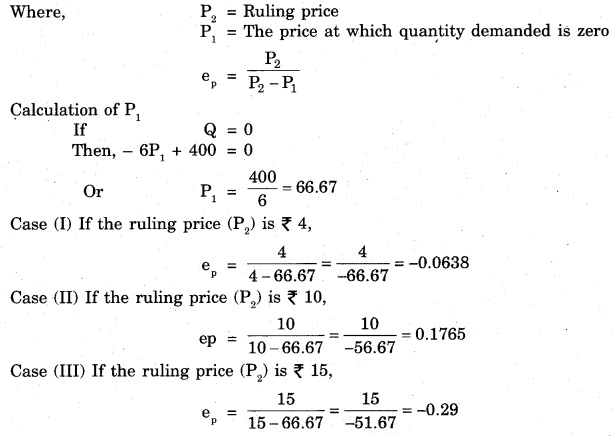
Question 6.
At ₹ 5 per unit, a consumer buys 40 units of a commodity and the price elasticity of his demand is (-)2. How much will he buy if the price reduces to ₹ 4 per unit?
Solution :
Suppose, the consumer will purchase Q1 units of the commodity.
